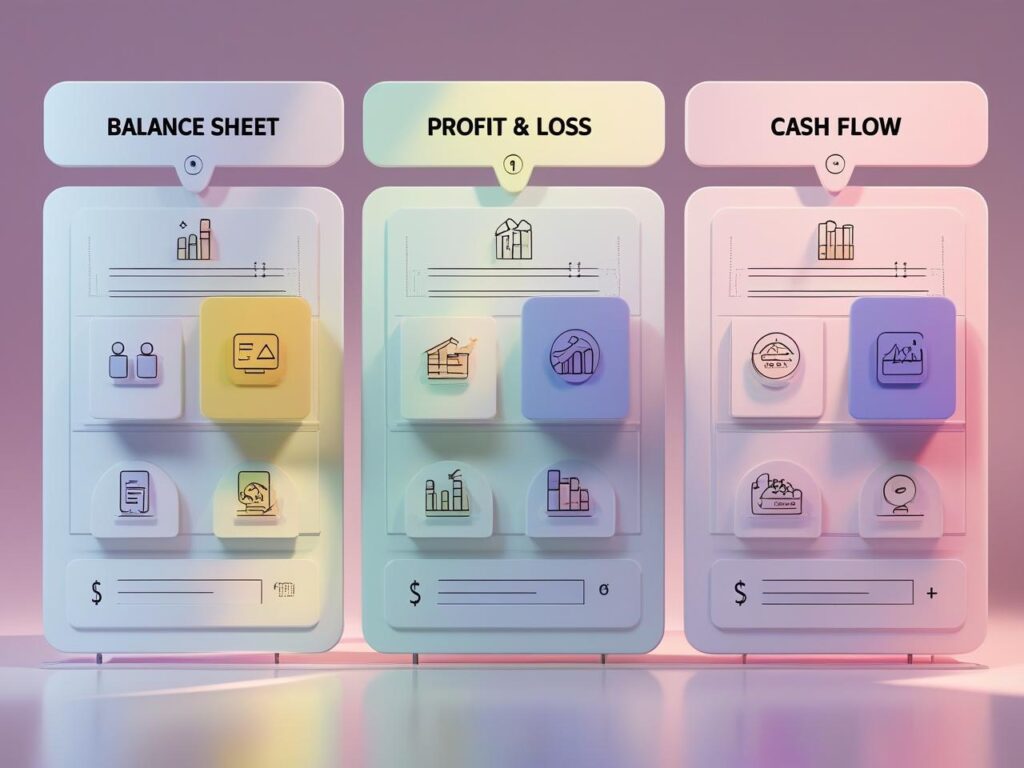
Balance Sheet, P&L, and Cash Flow — Explained Like You’re 5
🟡 Introduction: Why You Should Even Care About Financial Statements
Let’s be honest — financial statements can look like a mess of numbers and jargon. But once you understand them, they’re like x-ray reports of a business.
Whether you’re a small investor trying to pick the right stock, a freelancer trying to understand your earnings better, or just someone who wants to stop feeling clueless when you hear “net profit” — knowing how to read financial statements can help you make smarter financial decisions.
📘 1. What Exactly Are Financial Statements?
Think of financial statements as a report card for a business. They tell you:
- What the company owns (its assets)
- What it owes (its liabilities)
- How much money it’s making (or losing)
- Where the money is coming from and going
There are 3 main statements you’ll usually see:

| Statement | What it Shows |
| Balance Sheet | What the company owns vs. owes at a given time |
| P&L / Income Statement | How much the company earned or spent over a period |
| Cash Flow Statement | Where the cash is actually moving in or out |
👀 Why These Statements Matter?
Let’s say you want to invest in Company X. Would you invest without checking whether it’s making a profit or drowning in debt?
These statements give you the full story, not just what the company says in their ads.
🧾 2. The Balance Sheet — What a Company Owns vs. Owes
Imagine you’re looking inside a company’s wallet. That’s basically what a balance sheet does — it shows what the business owns, owes, and what’s left for the owners.
🧩 Balance Sheet = Assets = Liabilities + Equity
Here’s what’s inside:
✅ Assets (What the company owns):
- Current Assets (used within a year): cash, accounts receivable (money customers owe), inventory
- Non-current Assets (used for long-term): buildings, equipment, patents
❌ Liabilities (What the company owes):
- Current Liabilities (payable within a year): short-term loans, unpaid bills
- Long-term Liabilities: loans, bonds, etc.
👥 Shareholders’ Equity:
It’s what’s left after paying off all liabilities — kind of like the company’s “net worth.”
Example:
If a company owns ₹50 lakh worth of assets and owes ₹20 lakh, then ₹30 lakh is the owners’ equity. Simple math!
💼 3. The Profit & Loss (P&L) Statement — Is the Company Earning or Burning?
Also called the Income Statement, this one is all about money in vs. money out over a specific period (monthly, quarterly, yearly).
Here’s how it flows:
| Element | Description |
| Revenue | Total money made from selling products/services |
| Expenses | What it cost to run the business |
| Net Profit / Loss | What’s left after expenses (aka the “bottom line”) |
Example:
Suppose a small bakery made ₹10 lakh in revenue but spent ₹7 lakh on ingredients, salaries, and rent. That’s ₹3 lakh in profit.
But don’t stop here! A company could show a profit but still be struggling with actual cash. That’s where the next statement comes in.
Master Intraday Trading in 1 Day – Unlock Daily Profit Power
💵 4. Cash Flow Statement — The Real Deal Behind the Money
This is the most ignored but super important financial statement.
Imagine this: A business shows ₹5 lakh profit on paper, but they haven’t collected payments from customers. Guess what? They might not be able to pay their own bills.
The cash flow statement tracks the actual cash coming in and going out.
🔄 Three Sections of Cash Flow:
| Type | What’s In It |
| 🟢 Operating Activities | Money made/spent from core business (sales, salaries) |
| 🟠 Investing Activities | Buying/selling property, equipment |
| 🔴 Financing Activities | Borrowing, repaying loans, issuing shares |
Real-life example:
A company shows profit but also huge cash outflow from buying new machinery. This might be good for long-term growth, but they’ll need enough cash to stay afloat in the short term.
🔁 5. How to Read All Three Statements Together
Reading just one statement is like watching one episode of a series. You might get the gist, but you’ll miss the full story.
Here’s how to connect the dots:
- The P&L tells you: Is the business profitable?
- The Cash Flow tells you: Is the business handling cash well?
- The Balance Sheet tells you: Is the business stable and strong over time?
Imagine a business that’s profitable, but drowning in debt. The balance sheet will show heavy liabilities, even if the P&L looks healthy.
⚠️ 6. Common Mistakes Beginners Make
❌ Focusing Only on Profits
Don’t fall for big “net profit” numbers. Always check whether those profits are converting into actual cash.
❌ Ignoring Cash Flow
Profit ≠ Cash. Many startups shut down not because they weren’t profitable, but because they ran out of cash.
👀 YouTube Video Recommendation
✅ 7. Practical Tips for Beginners
📌 Start Simple
Don’t try to become a CA on day one. Just start by identifying key sections: revenue, expenses, cash in/out, assets, liabilities.
📌 Look for Trends
Compare this year vs. last year. Is revenue growing? Are expenses under control? Is debt increasing?
📌 Use Real Examples
Pick your favorite company (listed on NSE or BSE), download its annual report (usually free), and try reading its balance sheet and P&L.
📌 Track Over Time
Check quarterly results to see if the company is improving or struggling. Numbers tell a story if you watch them consistently.
Best Books for Learn Financial Statements
- Financial Accounting and Reporting for Non-Accounting Students
- Money Matters for Nonprofits
- The Routledge Companion to Accounting History
🧠 Conclusion
Learning how to read financial statements is like unlocking the financial language of business. You don’t need to be a finance pro — just curious and consistent.
Once you’re comfortable, you’ll be able to look at any company and say, “Hmmm… I like what I see here,” or “Wait — something doesn’t feel right.”
It’s a superpower for investors, entrepreneurs, and even personal finance nerds like us. 💪
Related Posts You May Love:
- Top 5 High-Growth Mutual Funds for SIP in 2025 to Safely Build ₹1 Crore Corpus
- Top 5 Mutual Fund Apps for Beginners (2025 Guide)
- How to Start Investing in the Indian Stock Market with Just ₹1000
- 5 Intraday Trading Strategies That Actually Work for Beginners with ₹10,000 Capital
🙋 Frequently Asked Questions (FAQs)
1. Why should I bother reading financial statements?
Because it gives you an honest view of how a business is doing — beyond marketing or headlines.
2. How do I know if a company is profitable?
Check the P&L for net profit. But don’t forget to look at the cash flow to ensure that profit is actually turning into usable money.
3. Can I just look at the balance sheet?
Nope. It’s like checking a person’s bank balance without knowing their salary or expenses. You need the full picture.
4. What’s the difference between profit and cash flow again?
Profit is what’s left after all expenses. Cash flow is the actual cash movement — a profitable company might still have poor cash flow.
5. How often should I check these reports?
If you’re investing, check quarterly and yearly. For your own business, monthly is even better.
6. How can I improve?
Start reading real annual reports. Try interpreting them. Practice. Compare companies. The more you do it, the sharper your eye gets.
🔗 CTA:
👉 Want a simple worksheet to practice reading financial statements with real companies?